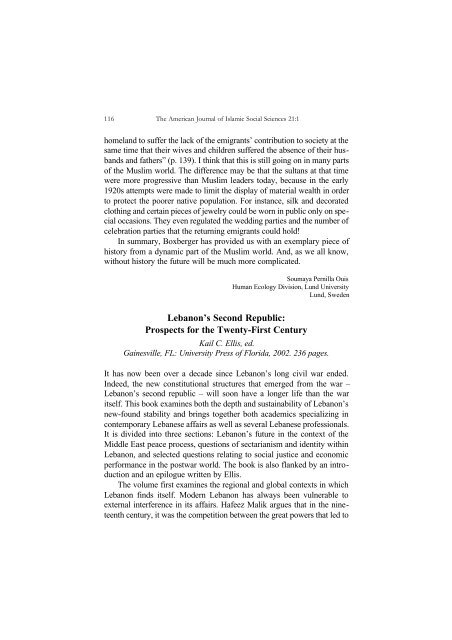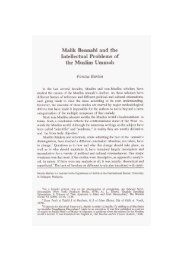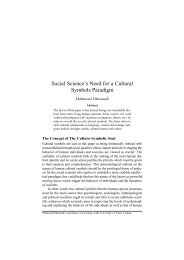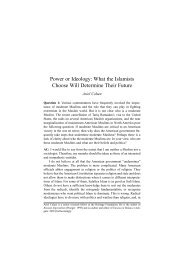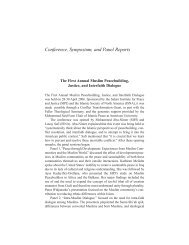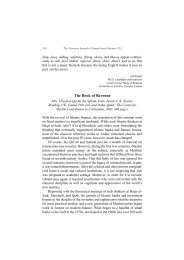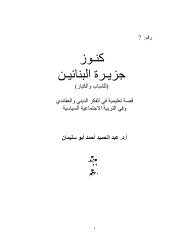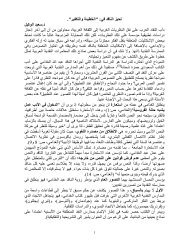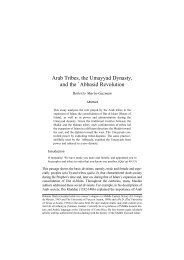Lebanon's Second Republic: Prospects for the ... - I-Epistemology
Lebanon's Second Republic: Prospects for the ... - I-Epistemology
Lebanon's Second Republic: Prospects for the ... - I-Epistemology
You also want an ePaper? Increase the reach of your titles
YUMPU automatically turns print PDFs into web optimized ePapers that Google loves.
116 The American Journal of Islamic Social Sciences 21:1<br />
homeland to suffer <strong>the</strong> lack of <strong>the</strong> emigrants’ contribution to society at <strong>the</strong><br />
same time that <strong>the</strong>ir wives and children suffered <strong>the</strong> absence of <strong>the</strong>ir husbands<br />
and fa<strong>the</strong>rs” (p. 139). I think that this is still going on in many parts<br />
of <strong>the</strong> Muslim world. The difference may be that <strong>the</strong> sultans at that time<br />
were more progressive than Muslim leaders today, because in <strong>the</strong> early<br />
1920s attempts were made to limit <strong>the</strong> display of material wealth in order<br />
to protect <strong>the</strong> poorer native population. For instance, silk and decorated<br />
clothing and certain pieces of jewelry could be worn in public only on special<br />
occasions. They even regulated <strong>the</strong> wedding parties and <strong>the</strong> number of<br />
celebration parties that <strong>the</strong> returning emigrants could hold!<br />
In summary, Boxberger has provided us with an exemplary piece of<br />
history from a dynamic part of <strong>the</strong> Muslim world. And, as we all know,<br />
without history <strong>the</strong> future will be much more complicated.<br />
Soumaya Pernilla Ouis<br />
Human Ecology Division, Lund University<br />
Lund, Sweden<br />
Lebanon’s <strong>Second</strong> <strong>Republic</strong>:<br />
<strong>Prospects</strong> <strong>for</strong> <strong>the</strong> Twenty-First Century<br />
Kail C. Ellis, ed.<br />
Gainesville, FL: University Press of Florida, 2002. 236 pages.<br />
It has now been over a decade since Lebanon’s long civil war ended.<br />
Indeed, <strong>the</strong> new constitutional structures that emerged from <strong>the</strong> war –<br />
Lebanon’s second republic – will soon have a longer life than <strong>the</strong> war<br />
itself. This book examines both <strong>the</strong> depth and sustainability of Lebanon’s<br />
new-found stability and brings toge<strong>the</strong>r both academics specializing in<br />
contemporary Lebanese affairs as well as several Lebanese professionals.<br />
It is divided into three sections: Lebanon’s future in <strong>the</strong> context of <strong>the</strong><br />
Middle East peace process, questions of sectarianism and identity within<br />
Lebanon, and selected questions relating to social justice and economic<br />
per<strong>for</strong>mance in <strong>the</strong> postwar world. The book is also flanked by an introduction<br />
and an epilogue written by Ellis.<br />
The volume first examines <strong>the</strong> regional and global contexts in which<br />
Lebanon finds itself. Modern Lebanon has always been vulnerable to<br />
external interference in its affairs. Hafeez Malik argues that in <strong>the</strong> nineteenth<br />
century, it was <strong>the</strong> competition between <strong>the</strong> great powers that led to
Book Reviews 117<br />
<strong>the</strong> creation of Lebanon’s religiously based sectarian political system,<br />
which was a departure from <strong>the</strong> longstanding reliance on tribal networks<br />
as a way of structuring political life. In <strong>the</strong> twentieth century, paralleling<br />
this global competition <strong>for</strong> power, now articulated through cold war logic,<br />
was <strong>the</strong> emergence of fierce competition <strong>for</strong> regional hegemony between<br />
Nasserism, Palestinian nationalism, and Israeli irredentism, all of which<br />
penetrated, destabilized, and eventually contributed to <strong>the</strong> breakdown of<br />
<strong>the</strong> Lebanese polity.<br />
This book clearly states that today, <strong>the</strong>se destabilizing regional and<br />
global influences have subsided <strong>for</strong> <strong>the</strong> time being and have been replaced<br />
by American acquiescence to Syrian hegemony over Lebanese affairs. In an<br />
interesting article on Israeli-Lebanese relations, Kirsten Schulze adds Israel<br />
to <strong>the</strong> list of powers acquiescing to this geo-strategic situation, having, in<br />
effect, abandoned any larger projects aimed at fostering <strong>the</strong> creation of a<br />
Christian ministate to its north. As Ellis stresses, however, Lebanon’s resultant<br />
stability remains grounded in uncertainty, since it is a hostage to<br />
progress in <strong>the</strong> region’s overall peace process.<br />
The second part focuses on Lebanon’s cultural and religious heritage.<br />
The contributors argue that sectarian identities have become more<br />
entrenched in <strong>the</strong> postwar world. Paul Nabil Sayyah’s article explains this<br />
phenomenon with respect to <strong>the</strong> increasing challenges faced by traditional<br />
elites, as well as <strong>the</strong> underlying social patterns of coexistence between religious<br />
communities, from such new religious movements as Hizballah,<br />
which are questioning Lebanon’s “pacted” system of power-sharing. Fur<strong>the</strong>r<br />
contributing to this predicament, argues Nabeel Haidar, is Lebanon’s educational<br />
system, which has largely failed to <strong>for</strong>ge a strong sense of Lebanese,<br />
as opposed to communal, identity. Thus, <strong>the</strong> people continue to view <strong>the</strong>ir<br />
particular religious leader as <strong>the</strong>ir “political mediator” instead of looking to<br />
<strong>the</strong> state.<br />
Perhaps <strong>the</strong> most pointed example of <strong>the</strong>se hardening communal barriers<br />
is found in Julie Peteet’s excellent article on <strong>the</strong> Palestinian community<br />
in Lebanon. Highlighting a new war and a postwar process of “o<strong>the</strong>ring,”<br />
she argues that Palestinian relations with <strong>the</strong> Lebanese have become more<br />
socially and spatially polarized, a development that has reversed a more<br />
blurred prewar reality. Camp borders are now “brutally” defined and <strong>the</strong><br />
extent of Palestinian working rights have been increasingly restricted, both<br />
of which have contributed to a dramatic deterioration in <strong>the</strong> community’s<br />
socioeconomic well-being. Mona Khalaf’s article on <strong>the</strong> status of women<br />
in postwar Lebanon paints a similar picture of marginalization, character-
118 The American Journal of Islamic Social Sciences 21:1<br />
ized both by <strong>the</strong> “feminization of poverty” as well as by <strong>the</strong> entrenchment<br />
of legal discrimination, symbolized by <strong>the</strong> difficulties in re<strong>for</strong>ming<br />
Lebanon’s religiously controlled personal status laws and courts.<br />
The third section deals with a variety of socioeconomic problems.<br />
Wassim Shahin’s article on <strong>the</strong> Lebanese economy provides a stark statistical<br />
analysis of its poor per<strong>for</strong>mance, though it only alludes to some of <strong>the</strong><br />
underlying causes, such as “inefficient allocations,” namely, corruption.<br />
More pointedly critical articles – indeed, along with that by Peteet, <strong>the</strong> volume’s<br />
best – are Fuad Hamdan’s examination of Lebanon’s ecological crisis<br />
and Michael Davie’s critique of Lebanon’s postwar plans <strong>for</strong> urban<br />
reconstruction. Hamdan refers to Lebanon as “drowning in its own waste,”<br />
plagued by a corrupt Council <strong>for</strong> Development and Reconstruction and a<br />
weak Ministry of <strong>the</strong> Environment. Davie similarly refers to <strong>the</strong> country’s<br />
“chaotic” urban landscape, where development is increasingly determined<br />
by <strong>the</strong> trade-offs among Lebanon’s sectarian elites. By excluding <strong>the</strong> possibility<br />
of grass-roots participation, this reality contributes to what Davie<br />
calls “a social deficit” in postwar Lebanon.<br />
This is not a comprehensive examination of Lebanon’s second republic,<br />
<strong>for</strong> <strong>the</strong>re is a very glaring omission: <strong>the</strong> <strong>for</strong>mal political process, namely,<br />
elections, Parliament, and <strong>the</strong> judicial system. Instead, <strong>the</strong> book gives a great<br />
deal – and in my mind undue – attention to questions of Muslim-Christian<br />
relations and dialogue. This deflects attention away from <strong>the</strong> real sources of<br />
sectarianism in Lebanon: entrenched elite power. Ellis also provides no<br />
editorial justification <strong>for</strong> why some topics were included and o<strong>the</strong>rs were<br />
omitted. Presumably, <strong>the</strong>se were simply <strong>the</strong> ones that emerged from <strong>the</strong> conference,<br />
sponsored jointly by Villanova and <strong>the</strong> Lebanese American<br />
University in 1998, on which this collection is based. In addition, many of<br />
<strong>the</strong> articles have a subjective feel to <strong>the</strong>m, <strong>for</strong> <strong>the</strong>y were written by Lebanese<br />
who are actively involved in <strong>the</strong> processes <strong>the</strong>y describe. While extremely<br />
useful as potential primary source materials <strong>for</strong> scholars, this makes <strong>the</strong>m<br />
somewhat less useful as pieces of objective analysis.<br />
Fur<strong>the</strong>rmore, this volume lacks a rigorous analytical focus, preferring<br />
instead to play it safe at a higher level of generalization and pragmatic prescription.<br />
To describe Lebanon as being a “hostage” to <strong>the</strong> peace process,<br />
<strong>for</strong> example, exaggerates its own lack of empowerment, however constrained<br />
it might be by outside <strong>for</strong>ces. The contributions of Peteet, Hamdan,<br />
and Davie address <strong>the</strong> country’s real fault lines in a more explicit manner:<br />
lamenting <strong>the</strong> predominance of elite alliances that, at present, determine <strong>the</strong><br />
direction of much of <strong>the</strong> country’s reconstruction processes, and arguing
Book Reviews 119<br />
instead <strong>for</strong> promoting “non-violent and democratic models of social trans<strong>for</strong>mation.”<br />
It is this “democratic deficit” in Lebanon, found at <strong>the</strong> political,<br />
economic, and social levels, that is <strong>the</strong> main obstacle clouding its prospects<br />
in this new century.<br />
These criticisms aside, however, this volume has a number of excellent<br />
contributions and reaches some sensible, if scattered, conclusions<br />
about <strong>the</strong> challenges that Lebanon faces.<br />
Paul Kingston<br />
Department of Political Science, University of Toronto<br />
Toronto, Canada<br />
Suits and Uni<strong>for</strong>ms: Turkish Foreign Policy<br />
since <strong>the</strong> Cold War<br />
Philip Robins<br />
Seattle: Washington University Press, 2003. 352 pages.<br />
Philip Robins contends that Turkish <strong>for</strong>eign policy has faced four challenges<br />
in four distinct periods of its history: (1) consolidating <strong>the</strong> emergent<br />
Turkish <strong>Republic</strong> through external recognition (1930s), (2) remaining<br />
neutral during <strong>the</strong> <strong>Second</strong> World War (1940s), (3) confronting <strong>the</strong><br />
challenge of Soviet expansionism (<strong>the</strong> cold war era), and (4) responding<br />
to <strong>the</strong> end of bipolarity (post-cold war era). Robins examines <strong>the</strong>se <strong>for</strong>eign<br />
policy issues in <strong>the</strong> last period.<br />
The main <strong>the</strong>sis of this work is threefold: First, Turkey is a status quo<br />
power in <strong>the</strong> way that its <strong>for</strong>eign policy elites have fastened <strong>the</strong>ir thinking<br />
and practice to <strong>the</strong> framework of “<strong>the</strong> sanctity of borders, of states, of<br />
multilateral institutions and of norms of conduct, even when it became<br />
clear that systemic changes had rendered some of <strong>the</strong>se continuities no<br />
longer tenable” (p. 6). <strong>Second</strong>, Turkey continues to be firmly oriented<br />
westwards in terms of its <strong>for</strong>eign relations, which are characterized by its<br />
strong commitment to NATO as well as its desire to join <strong>the</strong> European<br />
Union (EU). Finally, Turkish <strong>for</strong>eign policy has been characterized more<br />
by “caution than daring,” quoting Malik Mufti. Despite <strong>the</strong> increase in its<br />
power relative to its neighbors, Turkey has avoided an interventionist <strong>for</strong>eign<br />
policy by emphasizing <strong>the</strong> <strong>for</strong>mation of multilateral frameworks <strong>for</strong><br />
conflict resolution.<br />
Robins defends <strong>the</strong>se arguments by analyzing <strong>the</strong> international systemic<br />
and domestic politics context in which Turkish <strong>for</strong>eign policy is


